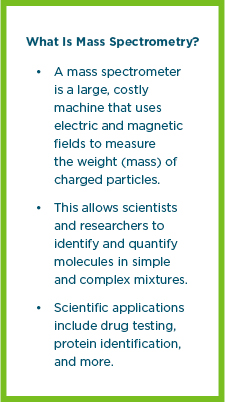MassMatrix Fuels Precision Medicine Innovation
Biotherapeutics, treatment produced from living cells instead of synthesized from chemicals, is the fastest growing sector in the pharmaceutical industry.
For this promising sector to achieve full potential, however, the industry needs faster, simpler, and more effective analysis tools to deal with the massive amounts of complex data that biotherapeutics requires.
That’s the mission of MassMatrix, a Columbus-based spinout from The Ohio State University. MassMatrix creates high-throughput, analytical solutions to address the unique needs of research institutions and pharmaceutical companies in biotherapeutics and life science research.
Biotherapeutics Is a Key Element in Precision Medicine
Innovations in biotherapeutics are a cornerstone of precision medicine—the idea that therapies can be targeted more specifically to a disease indication.
Precision medicine considers differences in people’s genes, environment, and lifestyle.

“The precision medicine evolution going on with bio-drugs is much more precise and targeted to specific indications,” said Hall Johnson, MassMatrix co-founder and CEO. “Every major pharmaceutical company is putting significant resources into discovering and developing these therapies. We are in the thick of that.”
Instead of manufacturing a synthetic molecule to a chemical specification in a lab, in biotherapeutics, nature is the manufacturing facility. Deriving molecules from living cells is sensitive to change and is much harder to control. In biotherapeutics to validate molecules, researchers use mass spectrometry to produce thousands, even millions of spectra which researchers then analyze.
“There is a significant bottleneck in the analysis of bio-drugs,” said Johnson. “In every aspect of the pipeline, from early discovery to development, testing, and manufacturing, scientists are constantly analyzing these large, organic, complex protein molecules to determine exactly what is in their samples.”
It takes people, resources, and software to go through thousands and millions of spectra. “Analysts and researchers use two or three software products with multiple windows open as they look back and forth between,” Johnson said. “If the information they are targeting isn’t clear, they may have to do another run on the mass spectrometer. Scheduling can be a problem. These million-dollar instruments run day and night.”
MassMatrix Applies Advanced Algorithms, AI, and Cloud Computing to Gain Faster Access to Results
The software that scientists use to analyze the output of mass spectrometry typically generates islands of information and produces reports that tend to be flat files—PDFs or PPTs. The systems are typically desktop, not cloud enabled. They are difficult to integrate with the rest of the information infrastructure.
Mass Matrix combines advanced algorithms and a modern user interface with experience and expertise to create high-throughput analytical solutions for complex biodata that are tailored to the unique needs of the biotherapeutics industry.
“If I am a process chemist working to lock down a process for a bio-drug, I get my report from a mass spectrometry lab. If I have questions, I call up the person who is doing the data analysis. This happens all the time. I can’t just bring up the software to answer my own questions,” Johnson said.
Another problem occurs when an analyst is attempting to identify possible sequence variances and site modifications in the amino acids of their protein molecule of interest.
“These issues can take days of testing and analysis,” Johnson said. “Current software isn’t up to the task. Our Small Business Innovation Research (SBIR) Phase II grant with the National Institutes of Health (NIH) is focused on speeding up this process with advanced machine learning algorithms and software tools to gleam knowledge from and account for all of the experimental evidence.”
Next Steps
MassMatrix has a founding team with deep expertise and knowledge. They have validated a large problem in a large market.
“We are creating a multi-omics platform for running high-throughput bioanalytical pipelines. Data will no longer be siloed and inaccessible. For the first time, the entire data universe will be available for mining by scientists across the enterprise via dynamic data dashboards.” Johnson said. “Every time we turn a corner, we are learning something new.”
Research reported in this publication was supported by the National Institute of General Medical Sciences of the National Institutes of Health under Award Number R44GM131484. The content is solely the responsibility of the authors and does not necessarily represent the official views of the National Institutes of Health.

